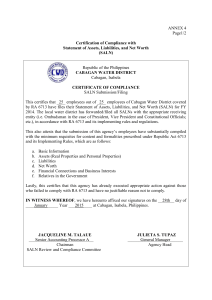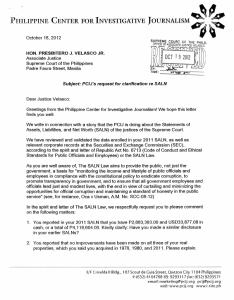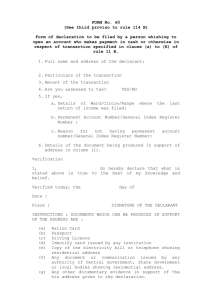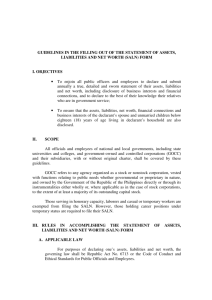REPUBLIC ACT NO. 6713
advertisement
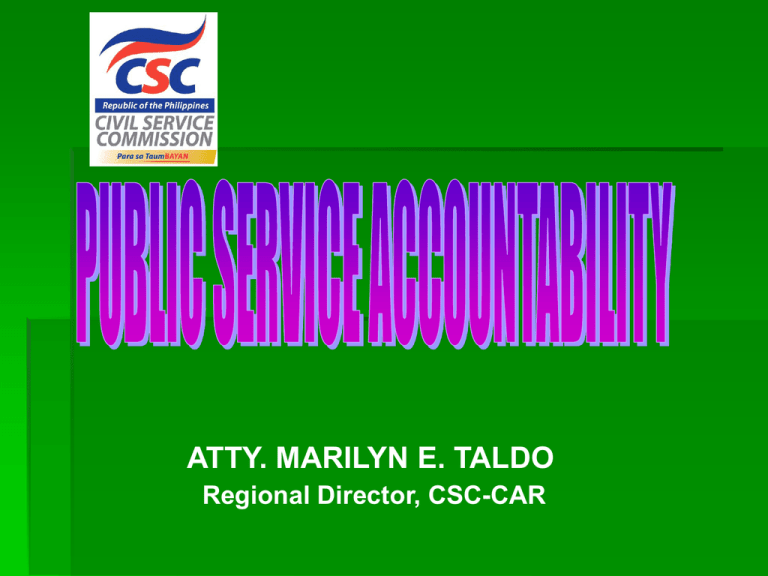
ATTY. MARILYN E. TALDO Regional Director, CSC-CAR Code of Conduct and Ethical Standards for Public Officials and Employees Coverage “All officials and employees in the government, elective and appointive, permanent or temporary, whether in the career or non-career service, including military and police personnel. Whether or not they receive compensation, regardless of amount.” Republic Act No. 6713 deals on the following: Norms of Conduct of Public Officials and Employees Duties of Public Officials and Employees Prohibited Acts and Transactions Statements and Disclosure Divestment, and Penalties Civil Service Commission Has the primary responsibility for the administration and enforcement of RA 6713, which among others includes the enforcement of the SA (Sec. 12, RA 6713) RA 6713, Section 8 (Statements and Disclosure) “Public officials and employees have an obligation to accomplish and submit declarations under oath of, and the public has the right to know, their assets, liabilities, net worth and financial and business interests including those of their spouses and of unmarried children under eighteen (18) years of age living in their households.” Article XI, 1987 Philippine Constitution “Section 17. A public officer or employee shall, upon assumption of office and as often thereafter as may be required by law, submit a declaration under oath of his assets, liabilities, and net worth. xxx” What is the SALN? statement of assets, liabilities and net worth; disclosure of financial connections or business interests; identification of relatives within the fourth degree of consanguinity or affinity, which also include bilas, balae and inso Why one must file the SALN? Government official/ employee occupies a position vested with public trust. Thus, requiring him/her to put public interest over and above his/her own. The primary use of the information on the SALN form is to exhibit TRANSPARENCY & ACCOUNTABILITY. Why is there a need for change? The previous form was found to be deficient. As a result of such, government agencies cannot fully prosecute erring officials with regard to unexplained wealth. To remove the confusion in the filling up of the SALN Form. What was the action taken? CSC constituted a Technical Working Group. PURPOSE: To review the SALN Form in order to cure its incompleteness and to make the same in full compliance with the applicable laws. In 2011, CSC issued the Revised SALN Form incorporating the agreements made during the SALN-TWG meetings. What was the action taken? However, the Revised SALN Form was met with oppositions from several government sectors. Some of the issues raised include: SALN Form is burdensome to fill up. The legal basis is not correct. What was the action taken? On March 15, 2012, CSC resolved to defer the use of the Revised SALN Form and allowed the use of the previous form (1994 SALN Form). On March 16, 2012, the Commission agreed to re-constitute the TWG to resolve the issues facing the SALN Form. Members of the TWG Office of the President; Senate of the Philippines; House of Representatives; Supreme Court; Office of the Ombudsman; Commission on Audit; Department of Justice; Department of Finance; Department of Budget and Management; Department of the Interior and Local Government; Governance Commission for GOCCs Members of the TWG From the public sector unions Philippine Government Employees Association Confederation of Independent Unions NEW SALN FORM CSC Resolution No. 1300173 dated January 24, 2013; CSC MC#2, S. 2013 Who are required to file? All officials and employees of: national and local governments state universities and colleges, and government-owned and controlled corporations (GOCC) and their subsidiaries, with or without original charter Who are exempted from filing? Those serving in honorary capacity; Laborers; and Casual or temporary workers. However, those holding career positions under temporary status are required to file their SALN. When to file? NEW ENTRANT FILING: Due within 30 calendar days from assumption to office; information must be as of declarant’s first day of service ANNUAL FILING: Due not later than April 30 of every year; information as of December 31 of the reporting period When to file? SEPARATION: Due within 30 days after separation from government service Basic Features The following declarations have been removed: Amount and sources of income; Amount of personal and family expenses; Amount of income taxes paid. Basic Features Declaration of nature of real properties was removed. The subcategories under personal properties, i.e. Tangible and intangible were removed. The basis of assessed value and current fair market value was clarified, that is, it should be the amount found in tax declaration of the real properties. Basic Features On the filing of spouses who are both government employees, the manner by which they should file their SALN was clarified. Identification of relatives is required to be “to the best of my knowledge” and the other declarations are “true and correct statements” Basic Features The SALN Form is now easier to fill up. Most of the changes have been made in the guidelines clarifying matters raised in previous years. Fill it out together with the Guidelines which was arranged to match the sequence of information needed from the declarant. How does one fill out the SALN Form? Basic Information Basic Information DECLARANT is single or married but whose spouse is not in the government service Tick off the box marked as “Not Applicable.” Declarant’s Children • new column on AGE. Real Properties • Refer to properties which are immovable by nature. • SALN purposes, real properties are classified according to their use, that is, residential, commercial, agricultural, industrial, or mixed use and the like Real Properties DESCRIPTION - land only or land with building, a house and lot, condominium unit, or an improvement such as an extension or garage, and the like. IMPROVEMENTS – refer to all works that are constructed or introduced to the land, or repairs or improvements made to the land or building after its initial acquisition may be declared separately or together with the land to which it is attached Real Properties ACQUISITION COST – amount of money paid to acquire or own something also refers to the amount of expenses incurred for improvements introduced on a real property In the case of properties received gratuitously, e.g. donation or inheritance, no acquisition cost shall be declared Real Properties In all real properties, the fair market value and assessed value as found in the tax declaration shall be declared. Declarant to indicate/disclose those real properties already titled or registered under his/her name, spouse or unmarried children below 18 years of age & living in his/her household; including those covered by a deed of sale, inherited or subject of extra-judicial settlement of estate but not yet titled Personal Properties • Refer to jewelry, appliances, furniture, motor vehicles and other tangible/movable properties. • This shall also include investments or other assets, such as cash on hand or in bank, negotiable instruments, securities, stocks, bonds, and the like Declaration of Assets CO-OWNED PROPERTIES - declarant shall disclose the proportionate amount of his share in the property PROPERTIES SUBJECT OF A CONTRACT TO SELL the amount already paid shall be declared as personal property MORTGAGED PROPERTY – the actual purchase price is the acquisition cost LIABILITY to be declared shall be the outstanding balance of the loan as of December 31 of the preceding year Liabilities Refer to financial liability or anything that can result to a transfer or disposal of an asset. NATURE OF LIABILITY - type of loan obtained from banks, financial institutions, GSIS, PAGIBIG and others, such as personal, multipurpose, salary, calamity loan and the like OUTSTANDING BALANCE - amount of money that one still owes on the loan as of December 31 of the preceding calendar year Computation of Net Worth NET WORTH - sum of all assets (real and personal) less total liabilities In real properties, the acquisition cost shall be used in the computation of the net worth In personal properties, the acquisition cost or amount/value of money shall be used in the computation of the total net worth What are excluded in the computation? Properties of unmarried children below 18 years of age living in the declarant’s household Paraphernal or capital properties of declarant’s spouse Spouses who are both public officers or employees In case of separate filing paraphernal or capital properties shall not be included in the computation of the declarant’s net worth In case of joint filing the total assets of the spouses shall include their respective paraphernal or capital properties SALN Form – page nd 2 Business Interests/ Financial Connections and Relatives in the Government Business Interests / Financial Connections BUSINESS INTERESTS - declarant’s existing interest in any business enterprise or entity, aside from his/her income from government FINANCIAL CONNECTIONS - declarant’s existing connections with any business enterprise or entity, whether as a consultant, adviser and the like, with an expectation of remuneration for services rendered Nature of Interest refers to existing interest or connection in any business enterprise, whether as proprietor, investor, promoter, partner, shareholder, officer, managing director, executive, creditor, lawyer, legal consultant or adviser, financial or business consultant, and the like Relatives in the Government Relatives Within the 4th Degree AFFINITY - relationship of a husband to the blood relatives of his wife, or a wife to the blood relatives of her husband CONSANGUINITY - relationship by blood from the same stock or common ancestor Relatives Within the 4th Degree 1st degree 2nd degree Consanguinity Affinity Parents Children Grandparents Grandchildren Siblings Parents-in-law Grandparents-in-law Brother-in-law Sister-in law Relatives Within the 4th Degree Consanguinity Affinity 3rd degree Uncle/Aunt Nephew/Niece Uncle/Aunt-in-law Nephew/Niece-in-law 4th degree 1st Cousin 1st Cousin-in-law 4 Great Grandparent 3 Brothers/ Sisters of Grandparents Grandparents 2 Parents 3 Uncles/ Aunts 1 2 4 Brothers/ Sisters 1st Degree Counsin/s DECLARANT 1 Children 2 Grandchildren 3 Great Grandchildren 4 Great Great Grandchildren 3 Nephews/ Nieces 4 Grand Nephews/ Nieces Who else are included? Balae a parent of the declarant’s son-in-law or daughter-inlaw Bilas declarant’s brother-in-law's wife or sister-in-law's husband Inso appellation for the wife of an elder brother or male cousin Certification and Signature Certification and Signature Declaration should be true and correct statements Identification of the relatives is only to the best of the declarant’s knowledge Both spouses should sign, whether in the government or private sector If signature cannot be acquired, an explanation should be attached Pagination The format should indicate the total number of pages of the SALN in case additional sheets are used Such as: Page 1 of 3 Page 2 of 3 Page 3 of 3 PURPOSE: To avoid insertions or pulling out of pages. Additional Sheets Sample sheets for: • Declarant • Declarant’s spouse and unmarried children below 18 years of age living in the household Additional Sheets Indicate: name of the declarant position agency name year covered by the SALN, shall be signed on each page Who can administer oath? The heads of agencies Those authorized by the head of agency to administer oath Those authorized by law to administer oath, i.e. notaries public The authority to administer oath must be in writing. Other reminders No unnecessary markings. Fill all applicable information. Otherwise, write “not applicable” or “N/A.” Filling up the form may be handwritten, computerized or typed. Handwriting must be legible. Violations of Public Officers Failure of an official or employee to submit his/her SALN; and Failure to disclose or misdeclaration of any asset, liability, business interest, financial connection, and relative in the government in his/her SALN Penalties FIRST OFFENSE suspension of one (1) month and one (1) day to six (6) months SECOND OFFENSE dismissal from the service Violation of Head of Agency SIMPLE NEGLECT OF DUTY failure to comply with CSC Memorandum Circular No. 10, s. 2006, in relation to the Review and Compliance Procedure in the Filing and Submission of the SALN Form PENALTY FIRST OFFENSE : suspension of one (1) month and one (1) day to six (6) months SECOND OFFENSE: dismissal from the service SALN REVIEW & COMPLIANCE COMMITTEE * Review and Compliance Committee Pursuant to Rule VIII of the Rules Implementing the Code of Conduct and Ethical Standards for Public Officials and Employees, as amended by CSC Resolution No. 06-0231 dated February 1, 2006 (re: establishment of a standard review and compliance procedure for the review of SALN), a Review and Compliance Committee is composed of a Chairman and two (2) Members who shall evaluate the SALN Form submitted to determine whether it was submitted on time, accomplished completely and proper in form. CSC Resolution No. 06-0231, dated February 1, 2006 Review and Compliance Procedure in the Filing and Submission of the Statement of Assets, Liabilities and Net Worth and Disclosure of Business Interests and Financial Connections Duties of the Chief/Head of the Personnel/ Administrative Division or Unit/ HRMO Upon receipt of SALN forms, evaluate whether properly accomplished [all applicable information /required details provided by filer; items not applicable marked “N/A”] Submit list of employees in alphabetical order, who: a) filed their SALNs with complete data b) filed their SALNs but with incomplete data c) did not file their SALNs, to the head of office, copy furnished the CSC, on or before May 15 of every year Transmit all original copies of the SALNs received, on or before June 30 of every year, to the concerned offices Where to File SALN National Office of the Ombudsman - President & Vice-Pres. of the Phils. - Chairmen and Commissioners of CCs Secretary of the Senate - Senators Sec. General of the HR - Congressmen Clerk of Court of the Supreme Court - Justices of the SC, CA, SB & CTA Court Administrator - Judges of the RTC, MCTC, M & SC Office of the President - National Executive Officials [Members of the Cabinet, Usec, Asec & FSOs] Office of the President - Heads of GOCCs w/ original charters & subsidiaries & SUCs - Officers of the AFP from rank of Colonel or Naval Captain Deputy Ombudsman - Regional Officials & employees of Depts., Bureaus & Agencies of the NG, Judiciary & CCs & Offices, GOCCs & subsidiaries in the region - other officials & employees of SUCs Deputy Ombudsman - Regional Officers of AFP below Colonel or Naval Captain & Civilian Personnel - PNP Regional Officials & employees - Provincial Officials & employees including Governors, Vice-Govs & SP members Deputy Ombudsman - Municipal/City Officials & employees including Mayors, ViceMayors, SB/P Members & Barangay Officials Civil Service Commission - All other Central Officials & Employees of NGAs, Judiciary, CC/Os, GOCCs & subsidiaries Civil Service Commission - Appointive Officials & employees of the Legislature - All other Central Officers below Colonel or Naval Captain & Civilian Personnel of AFP - All other U/NU Central Officials/Employees of PNP, BJMP & BFP Duty of Head of Office Within five (5) days from receipt of the list, Head of Office shall issue an ORDER requiring those with incomplete data in their SALN to correct/supply desired information and those who did not file/ submit, to comply within a nonextendible period of thirty (30) days from receipt of the order Failure to comply, ground for disciplinary action CSC RES. NO. 1300174 d. Jan. 24. 2013 [amended Secs. 3 & 4 of Res. No. 060231 d. Feb. 1, 2006]; MC No. 3, d. Jan. 24, 2013 “Section 3. Ministerial Duty of the Head of Office to Issue Compliance Order. Within five (5) days from receipt of the aforementioned list and recommendation, it shall be the ministerial duty of the Head of Office to an order requiring those who have incomplete data in their SALN to correct/supply the desired information and those who did not file/submit their SALNs to comply within a non-extendible period of thirty (30) days from receipt of the said Order.” “Section 4. Sanction for Failure to Comply/Issuance of a Show Cause Order. Failure of an official or employee to correct/submit in accordance with the procedure and within the given period pursuant to the directive in Section 3 hereof shall be a ground for disciplinary action. The Head of Office shall issue a show-cause order directing the official or employee concerned to submit his/her comment or counter-affidavit; and if the evidence so so warrants, proceed with the conduct of the administrative proceedings pursuant to the Revised Rules on Administrative Cases in the Civil Service (RRACCS), CSC Resolution No. 1101502 dated November 8, 2011. The offense of failure to file SALN is punishable under Section 46 (D)(8) of Rule X thereof, with the following penalties: First Offense – Suspension of one (1) month and one (1) day to six (6) months Second Offense – Dismissal from the service Public officials and employees who fail to comply within the thirty (30) day period required under Section 3 hereof or who submit their SALNs beyond the said period shall be considered as not having filed their SALNs, and shall be made liable for the offense of Failure to File SALN with a penalty of suspension of one (1) month and one (1) day to six (6) months for the first offense, and dismissal from the service for the second offense. Heads of agencies/offices who fail to comply with the provisions of CSC Resolution No. 06-231 dated February 1, 2006, as amended, shall be liable for Simple Neglect of Duty, which shall be punishable by suspension of one (1) month and one (1) day to six (6) months for the first offense and dismissal from the service for the second offense.”
